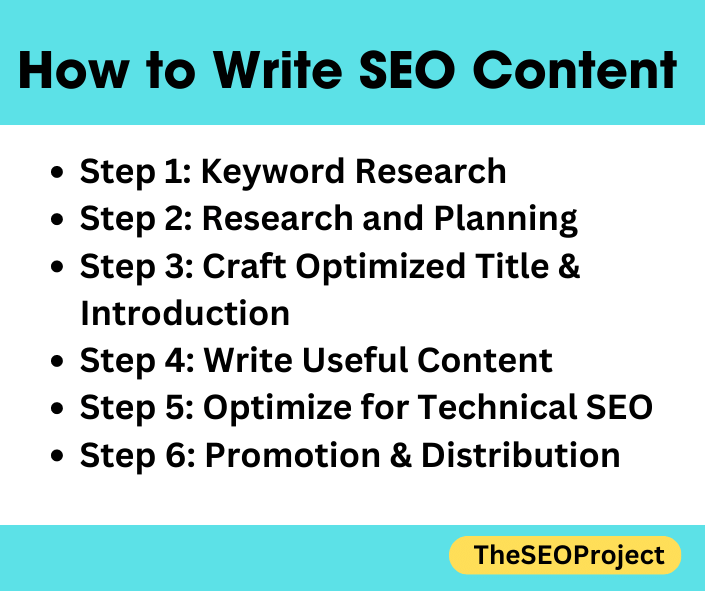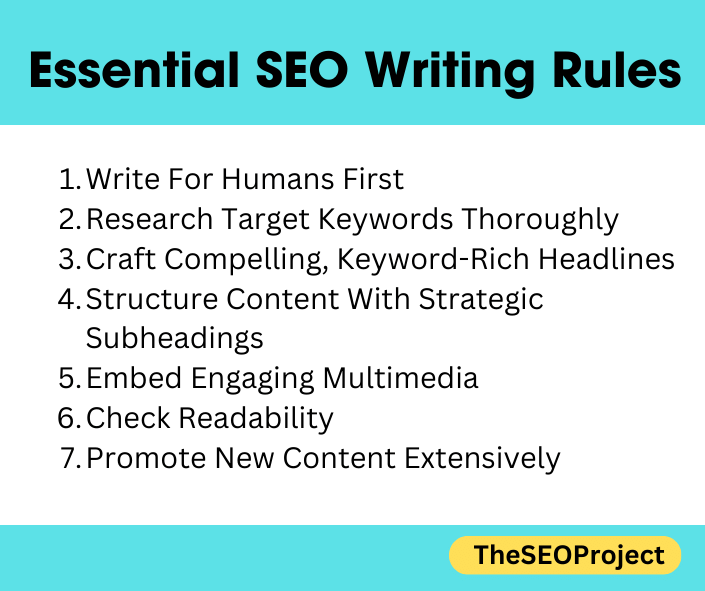For any website to have qualified organic traffic, knowing how to write SEO content and optimization is essential.
Creating quality SEO content involves much more than just stuffing keywords into articles.
You must follow a methodology and strategy to develop content that ranks high in search results and brings in visitors. In fact, according to Moz, content is one of the most important ranking factors, making up over 20% of Google’s algorithm.
In this guide, we will walk through a step-by-step process for crafting SEO content that attracts search traffic and boosts conversions. Following best-structured practices can improve your organic rankings and visibility over time.
Let’s dive into how to develop high-performing SEO content that connects with your audience and accomplishes business goals.
Why Writing SEO Content is Necessary?
In today’s digital landscape, creating SEO-friendly content should be a core part of any digital marketing strategy. Here are some key reasons why investing time and resources into SEO content is so important:
- SEO content is designed to be discoverable by search engines and users. This brings in targeted organic traffic to your site. Relying solely on paid ads can be expensive.
- Ranking high in search results builds authority and trust. Users see your content as a valuable resource when it shows up on the first page.
- Quality SEO content targets keywords people are searching for. That means you attract qualified visitors who are already interested in your offerings.
- Optimized content is shareable and can spread organically via links. This compounds traffic and conversions over time.
- SEO content marketing has a long-lasting effect on leads and sales. Unlike paid ads which stop working after you pause spending, SEO content continues to bring in traffic.
In essence, SEO content gets your brand and message in front of high-intent audiences that are actively looking for the solutions you provide. It delivers a considerable ROI compared to other forms of digital marketing.
How to Write SEO Content in 6 Steps
Creating SEO-friendly content that ranks high in search engines involves following some key steps and best practices. Here is a 6-step process to develop content optimized for driving traffic and conversions:

Step 1: Keyword Research
Thorough keyword research is the first critical step in crafting SEO content. You need to identify relevant target keywords and phrases that have good search volume and are reasonably easy to rank for as a starting point. Use keyword research tools like Semrush, Ahrefs, or Google’s Keyword Planner to find keywords aligned with your topic and target audience.
Analyze keywords to understand search volume and difficulty based on metrics like monthly searches and competition. Shortlist keywords that strike the right balance of having sufficient search volume as well as ranking feasibility.
Also, include a mix of head terms as well as longer tail variations for better reach. Picking the right keywords from the research phase provides the base for creating content that ranks well organically.
Pro Tip: We have been using Semrush for almost two years now and we have jotted our honest experience and review about the platform. Click here to know more.
Step 2: Research and Planning
Once you have your target list of primary and secondary keywords, the next step is developing a solid plan and outline for your content. Spend time deeply researching your topic and angles, especially for in-depth long-form posts.
Identify questions people are searching for around your keywords and ensure your outline is structured to answer these effectively. Look at what content already ranks on page one results and ensure you take a different approach to develop something unique. Proper planning and research are essential for creating useful content.
Step 3: Craft Optimized Title & Introduction
With your content architecture in place, you can start writing. Begin by optimizing two crucial elements – the title tag and the introduction paragraph.
The title tag plays a big role in click-through rates and search visibility. Include your primary keyword early while keeping the title compelling and under 60 characters.
The opening paragraph should contain the main keyword once or twice while quickly communicating the essence of your content. This helps search engines identify relevancy signals early on.
Step 4: Write Useful Content
The key to succeeding with SEO content is providing something truly useful for readers. Avoid excessive keyword stuffing or forcing topics just to target keywords.
Organically work your main and secondary keywords into the post in places like section headings, the URL, image names, etc. Use keywords as they fit naturally with what you are communicating. Provide value by presenting helpful information, ideas, tips, or data.
Also, include relevant LSI keywords or synonyms to help search engines grasp the content’s topic fully. The goal is keyword integration without compromising readability.
Step 5: Optimize for Technical SEO
Incorporate technical SEO optimization to maximize the search crawler’s ability to index and rank your content. Here are some key technical factors:
- Use keyword-rich headers and subheadings (H2, H3 tags).
- Include keywords in image file names and alt text.
- Optimize page load speed by compressing images and minimizing plugins.
- Structure content in short paragraphs with lots of white space.
- Use inbound links from other related pages to strengthen signals.
Step 6: Promotion & Distribution
The final step is promoting your content across channels to drive traffic. Share your content on social media, submit it to online aggregators, syndicate it to other sites, and reach out to relevant media outlets and influencers in your industry.
Distribute your content widely to get qualified visitors. Then analyze performance in analytics to identify high-performing channels and topics to guide future content efforts.
Following this step-by-step SEO content creation process will help you develop optimized, high-quality content that attracts organic search traffic and builds authority. Consistently produce such content to grow your visibility over time.
7 Essential SEO Writing Rules
Here are some essential writing rules for SEO content that everyone should follow:

1. Write For Humans First
The key foundation of effective SEO content is providing real value to human readers. Before you think about keywords and optimization, focus on creating useful, engaging content that people will genuinely benefit from. Offer actionable tips, interesting information, and a great reading experience. Content that truly helps people converts better.
2. Research Target Keywords Thoroughly
Conduct in-depth keyword research using tools like Ahrefs and Semrush to identify keywords and phrases people are searching for related to your topic. Look for keywords with sufficient search volume and reasonable competitiveness. Incorporate the primary keywords in titles and headers and secondary keywords in the body text. This ensures you’re optimizing for terms people search for.
3. Craft Compelling, Keyword-Rich Headlines
Headlines are critical for getting clicks from searchers. Come up with compelling headlines that create curiosity and get people to click while incorporating target keywords early in the headline. Keep headlines under 60 characters. Use tools like Coschedule Headline Analyzer to optimize.
4. Structure Content With Strategic Subheadings
Break up text under clear, keyword-rich subheadings (H2, H3 tags). It helps highlight important information people want to skim for. Subheads also signal to search engines what the content is about. Include target keywords in subheads where it fits naturally.
5. Embed Engaging Multimedia
Include visuals like images, graphics, videos, and illustrations throughout your content. It makes the content more visually engaging and easier to digest. Ensure you optimize images with keyword-rich file names, alt text, and captions. Videos also help with SEO if transcribed correctly.
6. Check Readability
Hemingway App is one of the best free tools that help users check grammar mistakes and readability by highlighting parts.
Paste your content into the Hemingway App to assess readability. The app highlights complex sentences and provides a readability grade level. Simplify any convoluted language so your content is easily scannable and understandable for readers and search bots.
7. Promote New Content Extensively
Once you publish new content, actively promote it across channels. Share it on social media, email subscribers, run social ads, and reach out to relevant media contacts. The more eyeballs you can drive to your content, the more potential traffic, backlinks, and conversions.
Related Reads:
Conclusion: How To Write SEO Content
Developing SEO content requires effort but pays dividends when done right. Begin with in-depth keyword and competitor research to identify opportunities and gaps. Plan content around user intent while weaving in keywords naturally. Incorporate technical optimizations to help search bots crawl and index pages.
Promote your content through multiple channels to maximize reach. Analyze performance to guide future efforts. Committing to this process will grow your organic visibility and traffic over time.
FAQs: How To Write SEO Content
SEO content writing is the process of creating content that is designed to be discoverable by search engines and users. The goal is to drive qualified organic traffic to a website by optimizing content for relevant keywords and phrases.
SEO content writing is important because it can help a website rank high in search results, build authority and trust, attract qualified visitors, and bring in long-lasting traffic. It can also deliver a considerable ROI compared to other forms of digital marketing.
The key steps in writing SEO content include conducting thorough keyword research, researching and planning the content, optimizing the title and introduction, writing useful content, optimizing for technical SEO, and promoting and distributing the content.
Essential writing rules for SEO content include writing for humans first, researching target keywords thoroughly, crafting compelling, keyword-rich headlines, structuring content with strategic subheadings, embedding engaging multimedia, checking readability, and promoting new content extensively.
Content quality is very important for SEO as it is one of the most important ranking factors, making up over 20% of Google’s algorithm. Providing something truly useful for readers, avoiding excessive keyword stuffing, and presenting helpful information, ideas, tips or data can help boost content quality.


